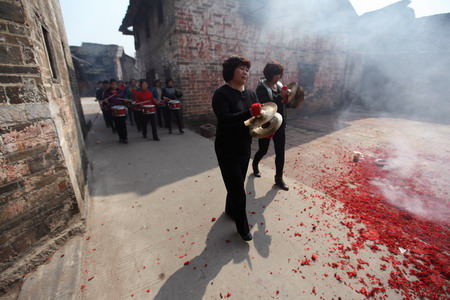Economy
'Red tourism' raises hopes
By Duan Yan (China Daily)
Updated: 2011-02-12 10:53
 |
Large Medium Small |
|
 |
|
Residents of Baishidu village on Feb 5 welcome tourists attracted by "red tourism". [Photo / Xinhua] |
In the hopes of bringing in more revenue from tourism, villagers chipped in to make improvements, repairing houses that had once lodged top Party leaders, building roads and erecting signs to guide visitors.
The villagers are not alone in their attempts to make money from red tourism, said He Lifen, a Yizhang publicity official.
In 2010, Yizhang county government invested 310 million yuan ($47 million) to renovate and improve the infrastructure of major historical sites.
China's giant network of high-speed railroads has also proved a benefit.
"Now it only takes two hours for tourists from Guangdong province to come here," said Kuang Pingyi, a 55-year-old photographer at Yizhang's Baishidu village, who is a volunteer guide for red tourism. Guangdong is a major source of tourists to Hunan.
As a result, more than 2.1 million people visited the county last year, up 72 percent from 2009.
|
||||
Throughout the country, red tourism programs have transformed mountain villages into attractions for domestic tourists who are interested in the country's revolutionary history.
According to Shao Qiwei, chief of the National Tourism Administration, the red tourism industry has expanded rapidly in the past six years. By the end of 2010, the total number of tourists attracted by revolutionary themes was around 1.3 billion, and the combined revenue produced was 400 billion yuan.
In Yizhang, red tourism has just started, according to He, the publicity official for the county. "There are lots of things that need to be done in the future."
Kuang Pingyi and his neighbors have been writing reports in search of more support from the local government. Among other requests, they called on the government to establish new bus stops.
"We also need to clean up the polluted river," Kuang said. "We can't do this without the government's support."
| 分享按钮 |



